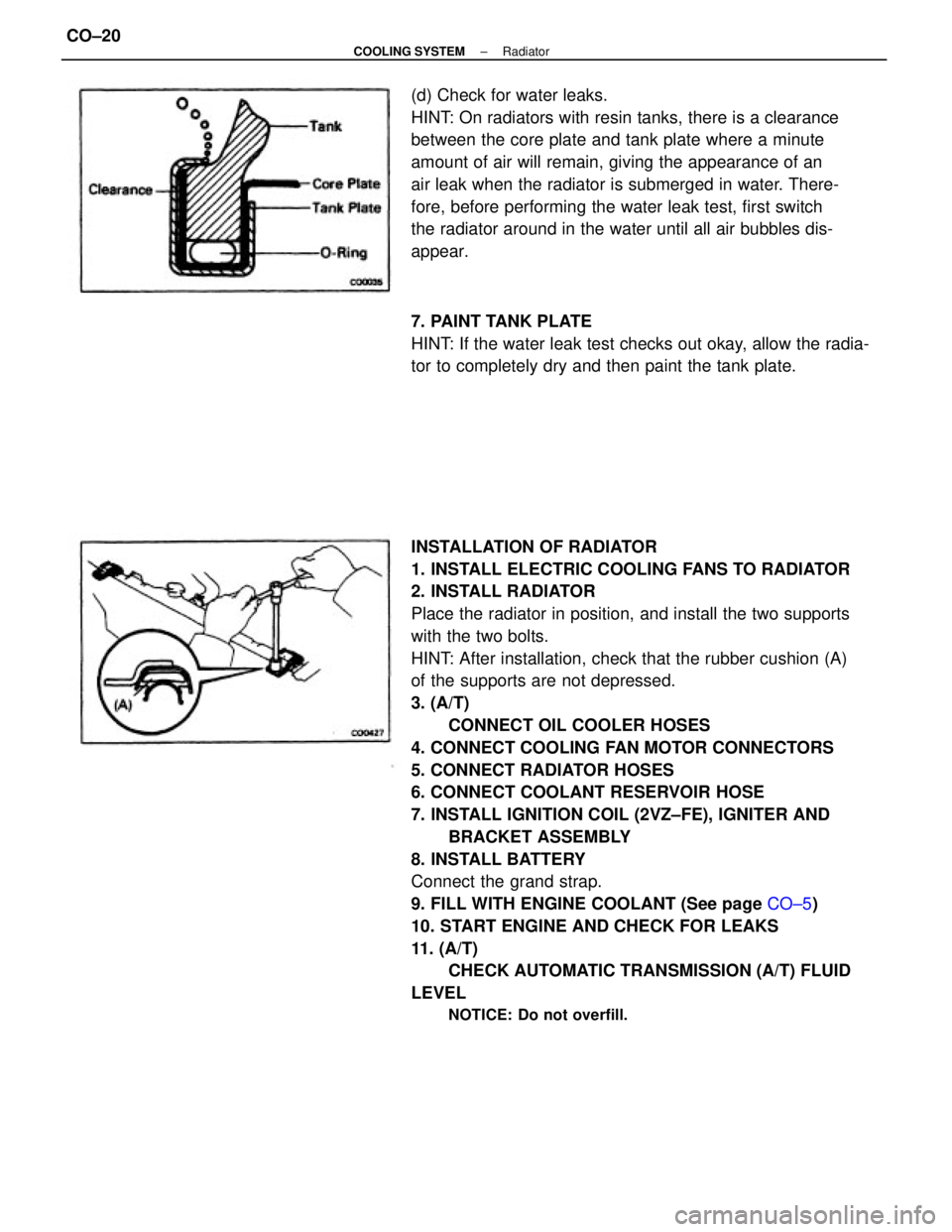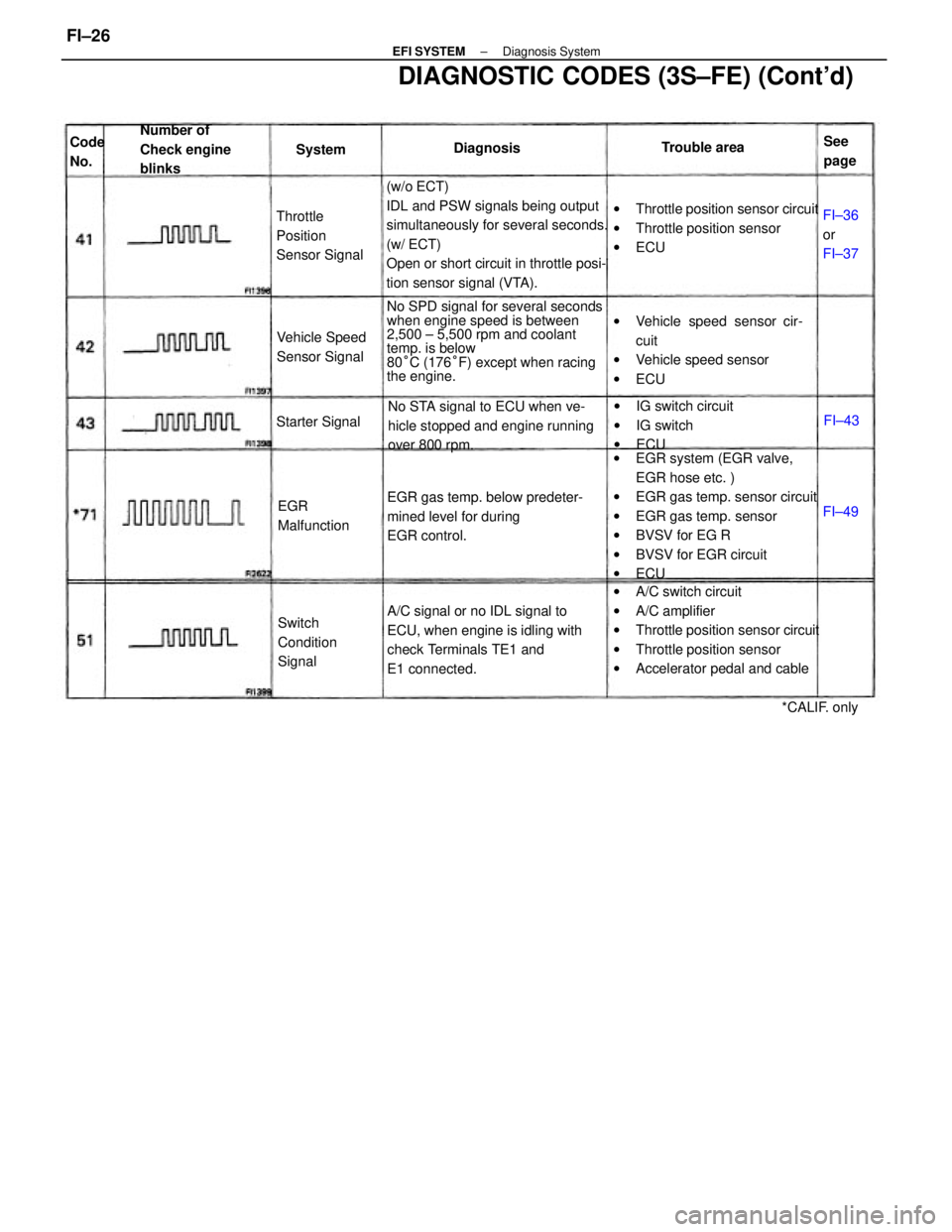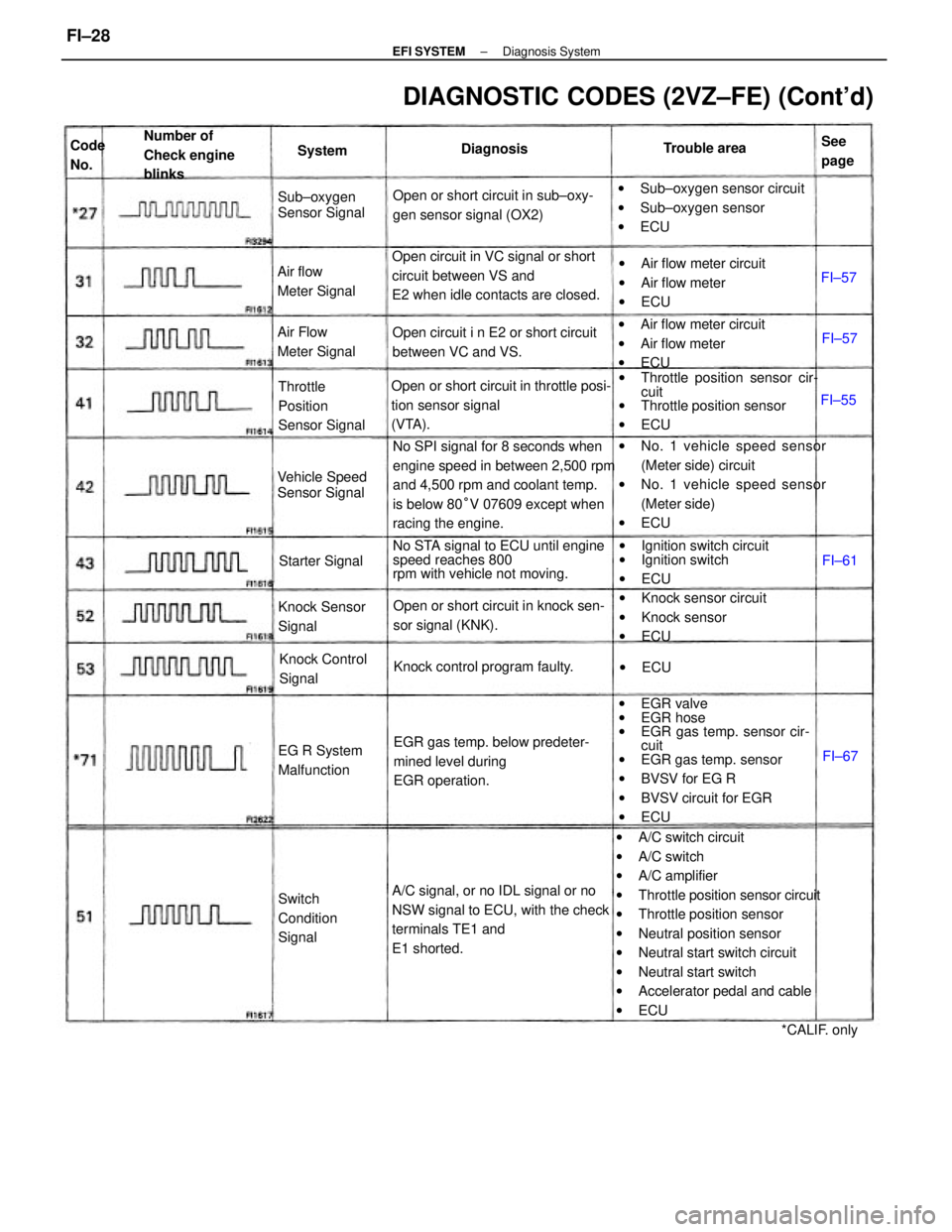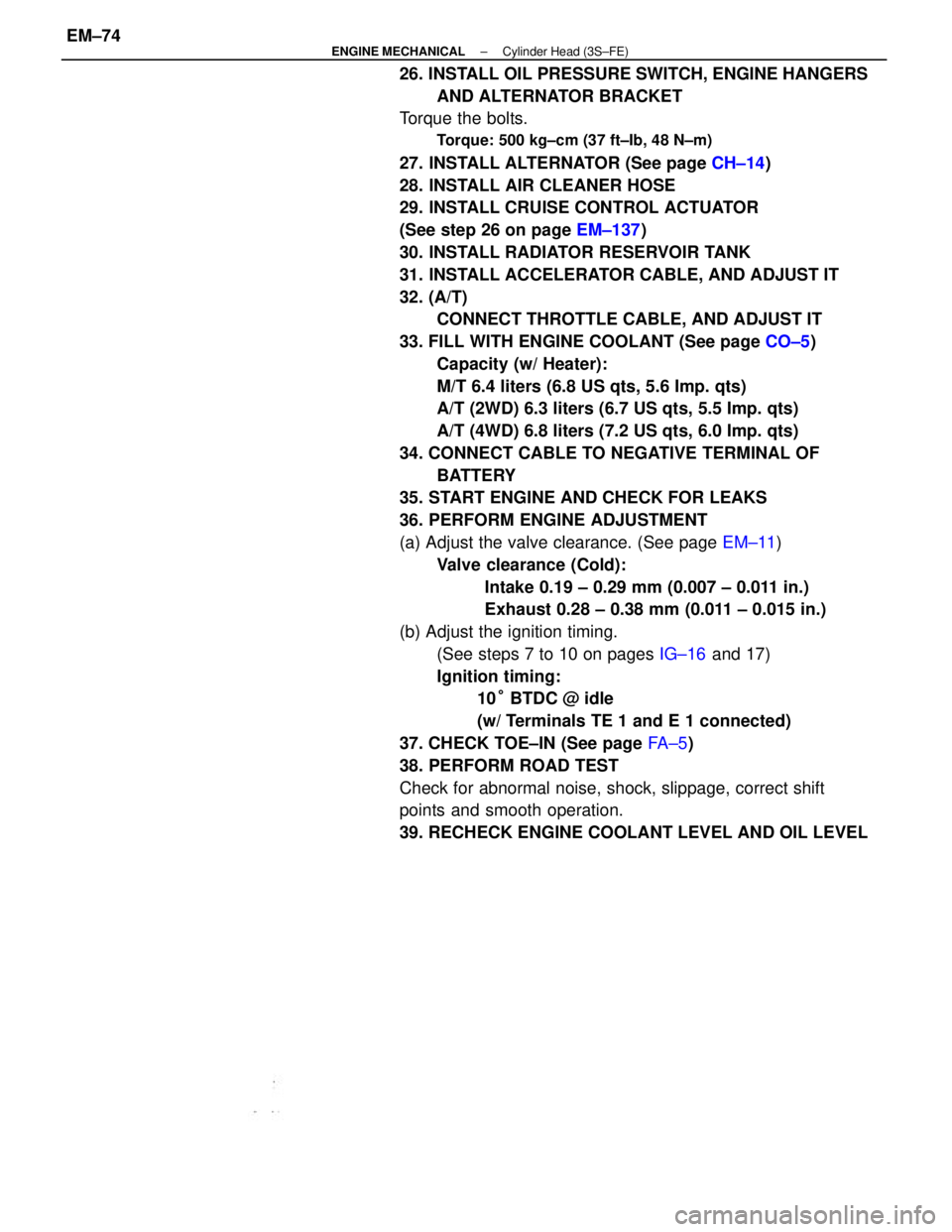1986 TOYOTA CAMRY V20 coolant level
[x] Cancel search: coolant levelPage 989 of 2389

The cooling system is composed of the water jacket (inside the cylinder block and cylinder head), radiator,
water pump, thermostat, electric fan, hoses and other components.
Coolant which is heated in the water jacket is pumped to the radiator, through which an electric fan blows air
to cool the coolant as it passes through. Coolant which has been cooled is then sent back to the engine by
the water pump, where it cools the engine.
The water jacket is a network of channels in the shell of the cylinder block and cylinder head through which
coolant passes. It is designed to provide adequate cooling of the cylinders and combustion chambers which
become heated during engine operation.
RADIATOR
The radiator performs the function of cooling the coolant which has passed through the water jacket and be-
come hot, and it is mounted in the front of the vehicle. The radiator consists of an upper tank and lower tank,
and a core which connects the two tanks. The upper tank contains the inlet for coolant from the water jacket
and the filler inlet. It also has a hose attached through which excess coolant or steam can flow. The lower
tank has an outlet and drain cock for the coolant. The core contains many tubes through which coolant flows
from the upper tank to the lower tank as well as cooling fins which radiate heat away from the coolant in the
tubes.
The air sucked through the radiator by the electric fan, as well as the wind generated by the vehicle's travel,
passes through the radiator, cooling the coolant. Models with automatic transmission include an automatic
transmission fluid cooler built into the lower tank of the radiator. A fan with an electric motor is mounted be-
hind the radiator to assist the flow of air through the radiator. The fan operates when the coolant tempera-
ture becomes high in order to prevent it from becoming too high.
RADIATOR CAP
The radiator cap is a pressure type cap which seals the radiator, resulting in pressurization of the radiator as
the coolant expands. The pressurization prevents the coolant from boiling even when the coolant tempera-
ture exceeds 100°C (212°F). A relief valve (pressurization valve) and a vacuum valve (negative pressure
valve) are built into the radiator cap. The relief valve opens and lets steam escape through the overflow pipe
when the pressure generated inside the cooling system exceeds the limit (coolant temperature: 110 ±
120°C, 230 ± 248°F, pressure; 0.3 ±1.0 kg/cm
2, 4.3 ±14.2 psi, 29.4 ± 98.1 kPa). The vacuum valve opens to
alleviate the vacuum which develops in the coolant system after the engine is stopped and the coolant tem-
perature drops.
The valves's opening allows the coolant in the reservoir tank to return to the cooling system.
RESERVOIR TANK
The reservoir tank is used to catch coolant which overflows the cooling system as a result of volumetric ex-
pansion when the coolant is heated. The coolant in the reservoir rank returns to the radiator when the cool-
ant temperature drops, thus keeping the radiator full at all times and avoiding needless coolant loss. Check
the reservoir tank level to find out if the coolant needs to be replenished.
WATER PUMP
The water pump is used for forced circulation of coolant through the cooling system. It is mounted on the
front of the cylinder block and driven by a timing belt.
THERMOSTAT
The thermostat has a wax type by±pass valve and is mounted in the water inlet housing. The thermostat in-
cludes a type of automatic valve operated by fluctuations in the coolant temperature. This valve closes when
the coolant temperature drops, preventing the circulation of coolant through the engine and thus permitting
the engine to warm up rapidly. The valve opens when the coolant temperature has risen, allowing the cir-
culation of coolant. Wax inside the thermostat expands when heated and contracts when cooled. Heating
the wax thus generates pressure which overpowers the force of the spring which keeps±the valve closed,
thus opening the valve. When the wax cools, its contraction causes the force of the spring to take effect
once more, closing the valve. The thermostat in this engine operates at a temperature of 82°C (180°F).
± COOLING SYSTEMDescriptionCO±3
Page 990 of 2389

3. (3S±FE)
REPLACE ENGINE COOLANT
(a) Remove the radiator cap.
CAUTION: To avoid the danger of being burned, do not re-
move it while the engine and radiator are still hot
as fluid and steam can be blown out under pressure.
(b) Drain the coolant from the .radiator and engine drain cocks.
(Engine drain cock at the right rear of engine block.)
(c) Close the drain cocks.
Torque (Engine drain cock):
130 kg±cm (9 ft±Ib, 13 N±m) HINT: If the engine tends to overheat, removal of the
thermostat will adversely effect cooling efficiency.
CHECK AND REPLACEMENT OF
ENGINE COOLANT
1. CHECK ENGINE COOLANT LEVEL AT RESERVE TANK
The coolant level should be between the ºLOWº and
ºFULLº lines.
If low, check for leaks and add coolant up to the ºFULLº
line.
Dirt, leaves or insects on radiator or condenser
Hoses, Water pump, thermostat housing, radiator,
heater, core, plugs or head gasket leakage
Thermostat faulty
Incorrect ignition timing
Electric cooling system faulty
Radiator hose plugged or rotted
Water pump faulty
Radiator plugged or cap faulty
Cylinder head or block cracked or water passage
clogged
2. CHECK ENGINE COOLANT QUALITY
There should not be any excessive deposits of rust or scales
around the radiator cap or radiator filler hole, and the cool-
ant should be free from oil.
If excessively dirty, replace the coolant.
Check thermostat
Reset tinning
Inspect electric cooling system
Replace hose
Replace water pump
Check radiator and cap
Repair as necessary
TROUBLESHOOTING
CO±12, 13
IG±17, 20
CO±20, 22 Clean radiator or condenser
Repair as necessary Engine overheats
Possible causeRemedy Problem
CO±6, 9 Page
± COOLING SYSTEM
TroubleshootingCO±4
Page 991 of 2389

3. (3S±FE)
REPLACE ENGINE COOLANT
(a) Remove the radiator cap.
CAUTION: To avoid the danger of being burned, do not re-
move it while the engine and radiator are still hot
as fluid and steam can be blown out under pressure.
(b) Drain the coolant from the .radiator and engine drain cocks.
(Engine drain cock at the right rear of engine block.)
(c) Close the drain cocks.
Torque (Engine drain cock):
130 kg±cm (9 ft±Ib, 13 N±m) HINT: If the engine tends to overheat, removal of the
thermostat will adversely effect cooling efficiency.
CHECK AND REPLACEMENT OF
ENGINE COOLANT
1. CHECK ENGINE COOLANT LEVEL AT RESERVE TANK
The coolant level should be between the ºLOWº and
ºFULLº lines.
If low, check for leaks and add coolant up to the ºFULLº
line.
Dirt, leaves or insects on radiator or condenser
Hoses, Water pump, thermostat housing, radiator,
heater, core, plugs or head gasket leakage
Thermostat faulty
Incorrect ignition timing
Electric cooling system faulty
Radiator hose plugged or rotted
Water pump faulty
Radiator plugged or cap faulty
Cylinder head or block cracked or water passage
clogged
2. CHECK ENGINE COOLANT QUALITY
There should not be any excessive deposits of rust or scales
around the radiator cap or radiator filler hole, and the cool-
ant should be free from oil.
If excessively dirty, replace the coolant.
Check thermostat
Reset tinning
Inspect electric cooling system
Replace hose
Replace water pump
Check radiator and cap
Repair as necessary
TROUBLESHOOTING
CO±12, 13
IG±17, 20
CO±20, 22 Clean radiator or condenser
Repair as necessary Engine overheats
Possible causeRemedy Problem
CO±6, 9 Page
± COOLING SYSTEMCheck and Replacement of Engine CoolantCO±4
Page 992 of 2389

(d) To release the air, loosen the union bolt of the water out-
let five revolutions.
(e) Slowly fill the system with coolant.
Use a good brand of ethylene±glycol base coolant,
mixed according to the manufacturer's directions.
Capacity (w/ Heater):
M/T 9.5 liters (10.0 US qts, 8.4 Imp. qts)
A/T 9.4 liters (9.9 US qts, 8.3 Imp. qts)
(f) Tighten the union bolt of the water outlet.
Torque: 180 kg±cm (13 ft±Ib, 18 N±m)
(g) Install the radiator cap.
(h) Start the engine and check for leaks.
(i) Recheck the coolant level and refill as necessary.
HINT: When the coolant has been depleted, refill with
coolant and repeat steps (d) to (i). 4. (2VZ±FE)
REPLACE ENGINE COOLANT
(a) Remove the radiator cap.
CAUTION: To avoid the danger of being burned, do not re-
move it while the engine and radiator are still hot as fluid
and steam can be blown out under pressure.
(b) Drain the coolant from the radiator and engine drain cocks.
(Engine drain cocks are at the front center and rear right
of the cylinder block.)
(c) Close the drain cocks.
Torque (Engine drain cock):
300 kg±cm (22 ft±Ib, 29 N±m)
NOTICE:
wDo not use alcohol type coolant.
wThe coolant should be mixed with demineralized
water or distilled water.
Capacity (w/ Heater).
M/T 6.4 liters (6.8 US qts, 5.6 Imp. qts)
A/T (2WD) 6.3 liters (6.7 US qts, 5.5 Imp. qts)
A/T (4WD) 6.8 liters (7.2 US qts, 6.0 Imp. qts)
(e) Install the radiator cap.
(f) Start the engine and check for leaks.
(g) Recheck the coolant level and refill as necessary. (d) Fill the system with coolant.
Use a good brand of ethylene±glycol base coolant, mixed
according to the manufacturer's directions.
Using coolant which includes more than 5O%
ethylene±glycol (but less than 70%) is recommended.
± COOLING SYSTEMCheck and Replacement of Engine CoolantCO±5
Page 1007 of 2389

INSTALLATION OF RADIATOR
1. INSTALL ELECTRIC COOLING FANS TO RADIATOR
2. INSTALL RADIATOR
Place the radiator in position, and install the two supports
with the two bolts.
HINT: After installation, check that the rubber cushion (A)
of the supports are not depressed.
3. (A/T)
CONNECT OIL COOLER HOSES
4. CONNECT COOLING FAN MOTOR CONNECTORS
5. CONNECT RADIATOR HOSES
6. CONNECT COOLANT RESERVOIR HOSE
7. INSTALL IGNITION COIL (2VZ±FE), IGNITER AND
BRACKET ASSEMBLY
8. INSTALL BATTERY
Connect the grand strap.
9. FILL WITH ENGINE COOLANT (See page CO±5)
10. START ENGINE AND CHECK FOR LEAKS
11. (A/T)
CHECK AUTOMATIC TRANSMISSION (A/T) FLUID
LEVEL
NOTICE: Do not overfill.
(d) Check for water leaks.
HINT: On radiators with resin tanks, there is a clearance
between the core plate and tank plate where a minute
amount of air will remain, giving the appearance of an
air leak when the radiator is submerged in water. There-
fore, before performing the water leak test, first switch
the radiator around in the water until all air bubbles dis-
appear.
7. PAINT TANK PLATE
HINT: If the water leak test checks out okay, allow the radia-
tor to completely dry and then paint the tank plate.
± COOLING SYSTEMRadiatorCO±20
Page 1040 of 2389

(w/o ECT)
IDL and PSW signals being output
simultaneously for several seconds.
(w/ ECT)
Open or short circuit in throttle posi-
tion sensor signal (VTA).
wEGR system (EGR valve,
EGR hose etc. )
wEGR gas temp. sensor circuit
wEGR gas temp. sensor
wBVSV for EG R
wBVSV for EGR circuit
wECU
wA/C switch circuit
wA/C amplifier
wThrottle position sensor circuit
wThrottle position sensor
wAccelerator pedal and cable No SPD signal for several seconds
when engine speed is between
2,500 ± 5,500 rpm and coolant
temp. is below
80°C (176°F) except when racing
the engine.
DIAGNOSTIC CODES (3S±FE) (Cont'd)
A/C signal or no IDL signal to
ECU, when engine is idling with
check Terminals TE1 and
E1 connected.wThrottle position sensor circuit
wThrottle position sensor
wECU
wVehicle speed sensor cir-
cuit
wVehicle speed sensor
wECU
EGR gas temp. below predeter-
mined level for during
EGR control.No STA signal to ECU when ve-
hicle stopped and engine running
over 800 rpm.wIG switch circuit
wIG switch
wECU Number of
Check engine
blinks
Throttle
Position
Sensor Signal
Switch
Condition
Signal Vehicle Speed
Sensor Signal
EGR
Malfunction Starter Signal
*CALIF. only Trouble area
FI±36
or
FI±37 DiagnosisSee
page Code
No.System
FI±49FI±43
± EFI SYSTEMDiagnosis SystemFI±26
Page 1042 of 2389

wA/C switch circuit
wA/C switch
wA/C amplifier
wThrottle position sensor circuit
wThrottle position sensor
wNeutral position sensor
wNeutral start switch circuit
wNeutral start switch
wAccelerator pedal and cable
wECU wEGR valve
wEGR hose
wEGR gas temp. sensor cir-
cuit
wEGR gas temp. sensor
wBVSV for EG R
wBVSV circuit for EGR
wECU No SPI signal for 8 seconds when
engine speed in between 2,500 rpm
and 4,500 rpm and coolant temp.
is below 80°V 07609 except when
racing the engine.wNo. 1 vehicle speed sensor
(Meter side) circuit
wNo. 1 vehicle speed sensor
(Meter side)
wECU
A/C signal, or no IDL signal or no
NSW signal to ECU, with the check
terminals TE1 and
E1 shorted. Open circuit in VC signal or short
circuit between VS and
E2 when idle contacts are closed.
wThrottle position sensor cir-
cuit
wThrottle position sensor
wECU
DIAGNOSTIC CODES (2VZ±FE) (Cont'd)
Open or short circuit in throttle posi-
tion sensor signal
(VTA).
No STA signal to ECU until engine
speed reaches 800
rpm with vehicle not moving.
EGR gas temp. below predeter-
mined level during
EGR operation.wSub±oxygen sensor circuit
wSub±oxygen sensor
wECU Open or short circuit in sub±oxy-
gen sensor signal (OX2)
wIgnition switch circuit
wIgnition switch
wECU wAir flow meter circuit
wAir flow meter
wECU wAir flow meter circuit
wAir flow meter
wECU
Open or short circuit in knock sen-
sor signal (KNK).wKnock sensor circuit
wKnock sensor
wECU Open circuit i n E2 or short circuit
between VC and VS.
Knock control program faulty. Throttle
Position
Sensor Signal Number of
Check engine
blinks
Knock Sensor
Signal
Switch
Condition
SignalKnock Control
Signal Air Flow
Meter Signal
Vehicle Speed
Sensor Signal Air flow
Meter SignalSub±oxygen
Sensor Signal
EG R System
MalfunctionStarter Signal
*CALIF. only Trouble area
DiagnosisSee
page System Code
No.
wECUFI±55FI±57
FI±57
FI±67 FI±61
± EFI SYSTEMDiagnosis SystemFI±28
Page 1251 of 2389

26. INSTALL OIL PRESSURE SWITCH, ENGINE HANGERS
AND ALTERNATOR BRACKET
Torque the bolts.
Torque: 500 kg±cm (37 ft±Ib, 48 N±m)
27. INSTALL ALTERNATOR (See page CH±14)
28. INSTALL AIR CLEANER HOSE
29. INSTALL CRUISE CONTROL ACTUATOR
(See step 26 on page EM±137)
30. INSTALL RADIATOR RESERVOIR TANK
31. INSTALL ACCELERATOR CABLE, AND ADJUST IT
32. (A/T)
CONNECT THROTTLE CABLE, AND ADJUST IT
33. FILL WITH ENGINE COOLANT (See page CO±5)
Capacity (w/ Heater):
M/T 6.4 liters (6.8 US qts, 5.6 Imp. qts)
A/T (2WD) 6.3 liters (6.7 US qts, 5.5 Imp. qts)
A/T (4WD) 6.8 liters (7.2 US qts, 6.0 Imp. qts)
34. CONNECT CABLE TO NEGATIVE TERMINAL OF
BATTERY
35. START ENGINE AND CHECK FOR LEAKS
36. PERFORM ENGINE ADJUSTMENT
(a) Adjust the valve clearance. (See page EM±11)
Valve clearance (Cold):
Intake 0.19 ± 0.29 mm (0.007 ± 0.011 in.)
Exhaust 0.28 ± 0.38 mm (0.011 ± 0.015 in.)
(b) Adjust the ignition timing.
(See steps 7 to 10 on pages IG±16 and 17)
Ignition timing:
10° BTDC @ idle
(w/ Terminals TE 1 and E 1 connected)
37. CHECK TOE±IN (See page FA±5)
38. PERFORM ROAD TEST
Check for abnormal noise, shock, slippage, correct shift
points and smooth operation.
39. RECHECK ENGINE COOLANT LEVEL AND OIL LEVEL
± ENGINE MECHANICALCylinder Head (3S±FE)EM±74